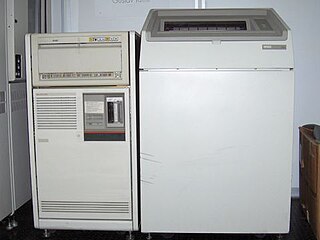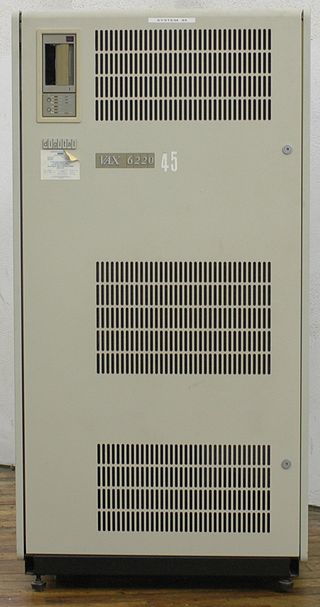
VAX is a series of computers featuring a 32-bit instruction set architecture (ISA) and virtual memory that was developed and sold by Digital Equipment Corporation (DEC) in the late 20th century. The VAX-11/780, introduced October 25, 1977, was the first of a range of popular and influential computers implementing the VAX ISA. The VAX family was a huge success for DEC, with the last members arriving in the early 1990s. The VAX was succeeded by the DEC Alpha, which included several features from VAX machines to make porting from the VAX easier.

VEB Kombinat Robotron was the largest East German electronics manufacturer. It was headquartered in Dresden and employed 68,000 people in 1989. Its products included personal computers, SM EVM minicomputers, the ESER mainframe computers, various computer peripherals as well as microcomputers, radios, television sets and other items including cookie press Kleingebäckpresse Typ 102.

The VAXstation is a discontinued family of workstation computers developed and manufactured by Digital Equipment Corporation using processors implementing the VAX instruction set architecture. VAXstation systems were typically shipped with either the OpenVMS or ULTRIX operating systems. Many members of the VAXstation family had corresponding MicroVAX variants, which primarily differ by the lack of graphics hardware.

The NVAX is a CMOS microprocessor developed and produced by Digital Equipment Corporation (DEC) that implemented the VAX instruction set architecture (ISA). A variant of the NVAX, the NVAX+, differed in the bus interface and external cache supported, but was otherwise identical in regards to microarchitecture. The NVAX+ was designed to have the same bus as the DECchip 21064, allowing drop-in replacement.

The CVAX is a microprocessor chipset developed and fabricated by Digital Equipment Corporation (DEC) that implemented the VAX instruction set architecture (ISA). The chipset consisted of the CVAX 78034 CPU, CFPA floating-point accelerator, CVAX clock chip, and the associated support chips, the CVAX System Support Chip (CSSC), CVAX Memory Controller (CMCTL), and CVAX Q-Bus Interface Chip (CQBIC).

The MicroVAX is a discontinued family of low-cost minicomputers developed and manufactured by Digital Equipment Corporation (DEC). The first model, the MicroVAX I, was first shipped in 1984. They used processors that implemented the VAX instruction set architecture (ISA) and were succeeded by the VAX 4000. Many members of the MicroVAX family had corresponding VAXstation variants, which primarily differ by the addition of graphics hardware. The MicroVAX family supports Digital's VMS, ULTRIX and VAXELN operating systems. Prior to VMS V5.0, MicroVAX hardware required a dedicated version of VMS named MicroVMS.

The U880 is an 8-bit microprocessor that was manufactured by VEB Mikroelektronik "Karl Marx" Erfurt in the German Democratic Republic. Production of the U880 started in 1980 at VEB Funkwerk Erfurt. The U880 is an unlicensed clone of the Zilog Z80 microprocessor, also supporting illegal opcodes and bugs, except for very minor differences like not setting the CY flag for the OUTI command.
The Firefly was a shared memory asymmetric multiprocessor workstation, developed by the Systems Research Center, a research organization within Digital Equipment Corporation. The first version built contained up to seven MicroVAX 78032 microprocessors. The cache from each of the microprocessors kept a consistent view of the same main memory using a cache coherency algorithm, the Firefly protocol. The second version of the Firefly used faster CVAX 78034 microprocessors. It was later introduced as a product by DEC as the VAXstation 3520/3540 codenamed Firefox.

The V-11, code-named "Scorpio", is a miniprocessor chip set implementation of the VAX instruction set architecture (ISA) developed and fabricated by Digital Equipment Corporation (DEC).
The DEC 7000 AXP and DEC 10000 AXP are a series of high-end multiprocessor server computers developed and manufactured by Digital Equipment Corporation, introduced on 10 November 1992. These systems formed part of the first generation of systems based on the 64-bit Alpha AXP architecture and at the time of introduction, ran Digital's OpenVMS AXP operating system, with DEC OSF/1 AXP available in March 1993. They were designed in parallel with the VAX 7000 and VAX 10000 minicomputers, and are identical except for the processor module(s) and supported bus interfaces. A field upgrade from a VAX 7000/10000 to a DEC 7000/10000 AXP was possible by means of swapping the processor boards.
The VAX 4000 is a discontinued family of low-end superminicomputers developed and manufactured by Digital Equipment Corporation using microprocessors implementing the VAX instruction set architecture (ISA). The VAX 4000 succeeded the MicroVAX family, and shipped with the OpenVMS operating system. It was the last family of low-end VAX systems, as the platform was discontinued by Compaq.

The VAX 6000 is a discontinued family of minicomputers developed and manufactured by Digital Equipment Corporation (DEC) using processors implementing the VAX instruction set architecture (ISA). Originally, the VAX 6000 was intended to be a mid-range VAX product line complementing the VAX 8000, but with the introduction of the VAX 6000 Model 400 series, the older VAX 8000 was discontinued in favor of the VAX 6000, which offered slightly higher performance for half the cost. The VAX 6000 family supports Digital's VMS and ULTRIX operating systems.
The VAX 7000 and VAX 10000 are a discontinued family of high-end multiprocessor minicomputers developed and manufactured by Digital Equipment Corporation (DEC), introduced in July 1992. These systems use NVAX microprocessors implementing the VAX instruction set architecture, and run the OpenVMS operating system.

The VAX 8000 is a discontinued family of superminicomputers developed and manufactured by Digital Equipment Corporation (DEC) using processors implementing the VAX instruction set architecture (ISA).

The MicroVAX 78032 is a microprocessor developed and fabricated by Digital Equipment Corporation (DEC) that implements a subset of the VAX instruction set architecture (ISA). The 78032 is used exclusively in DEC's VAX-based systems, starting with the MicroVAX II in 1985. When clocked at a frequency of 5 MHz, the 78032's integer performance is comparable to the original VAX-11/780 of 1977. The microprocessor can be paired with the MicroVAX 78132 floating point accelerator for improved floating point performance.

Rigel was a microprocessor chip set developed and fabricated by Digital Equipment Corporation (DEC) that implemented the VAX instruction set architecture (ISA). It was introduced on 11 July 1989 with the introduction of the VAX 6000 Model 400, the first system to feature the chip set. Rigel was also used in the VAX 4000 Model 300 and VAXstation 3100 Model 76. Production Rigel CPUs were rated at 35 to 43 MHz.

The MRB Z 1013 was an East German single-board computer produced by VEB Robotron Riesa, which was primarily intended for private use and educational institutions. It was powered by a U880 processor and sold together with a membrane keyboard. Initially, the kit was equipped with 16 kilobytes of DRAM, which was later replaced by a 64 KB version.

The K 1820, full name RVS K 1820, cipher in the SM EVM of the former COMECON countries SM 1720, is a workstation developed in East Germany. VEB Robotron Elektronik Dresden began development of the K 1820 in 1986 and it went into serial production in 1990.

The K 1840, full name RVS K 1840 is a minicomputer from the German Democratic Republic (GDR). Its development began in August 1985 at VEB Robotron Elektronik in Dresden, and it went into production in 1988.

VEB Kombinat Mikroelektronik Erfurt was an important manufacturer of active electronic components in East Germany. It should not be confused with the more well-known VEB Kombinat Robotron Dresden which used integrated circuits from Kombinat Mikroelektronik in its computers.
















